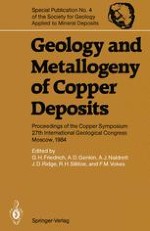1986 | Buch
Geology and Metallogeny of Copper Deposits
Proceedings of the Copper Symposium 27th International Geological Congress Moscow, 1984
herausgegeben von: Professor Günther H. Friedrich, Professor Alexandr D. Genkin, Professor Anthony J. Naldrett, Professor John D. Ridge, Dr. Richard H. Sillitoe, Professor Frank M. Vokes
Verlag: Springer Berlin Heidelberg
Buchreihe : Special Publication of the Society for Geology Applied to Mineral Deposits
Enthalten in: Professional Book Archive
